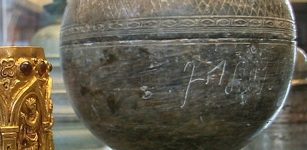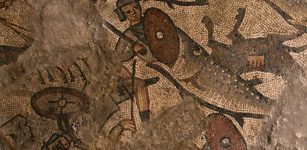Largest Ancient Embalming Cachette Ever Found Unearthed At Abusir, Egypt
Conny Waters – MessageToEagle.com – During routine excavations at the site of Abusir 30 km north of the Giza Plateau, excavators from the Czech Institute of Egyptology at the Charles University in Prague have discovered the largest cachette of ancient Egyptian embalming materials ever found in Egypt.
The largest cachette of ancient Egyptian embalming materials ever found in Egypt was discovered. During recent excavation work carried out at the site of Abusir, 30 km north of the Giza Plateau, a group of large shaft tombs situated at the western corner of the necropolis was found to contain the cachette. Image via Ahram Online
The institute has been excavating and exploring the remains of a 26th-Dynasty cemetery at Abusir for more than three decades. During recent excavation work conducted at the site, the team unearthed a group of large shaft tombs located at the western corner of the necropolis. These tombs were found to contain the cachette, reports Nevine El-Aref, Ahram Online
“With 370 large pottery storage jars and a number of smaller artifacts, it is probably the largest complex and undisturbed find of its kind originating from ancient Egypt,” said Mohamed Megahed, the deputy head of the mission.
He said that the vessels contained remnants or residues of various materials or utensils that had originally been used during the mummification process in ancient Egypt. They were found in a shaft more than 14 m deep adjacent to a large and still-unexcavated burial structure.
The vessels were laid together in 14 clusters situated at depths from four to 12 m below ground and adjoining the sides of the shaft in a spiral-like pattern. The number of vessels stored in each cluster varied from seven to 52 specimens.
In the uppermost group of vessels, four inscribed canopic jars made of limestone were found, all of them empty and unused. According to the texts inscribed on them, the jars belonged to a certain Wahibre-Mery-Neith, son of the Lady Irturu.
“The 2021 season was part of a long-term project aiming at excavating and interpreting monuments dating to a period when ancient Egyptian society was looking for new means to maintain its unique identity, then challenged by Greek, Persian and Nubian armies,” said the director of the mission Miroslav Bárta.
Image credit: Czech Institute of Egyptology at the Charles University, Praguw, Czech – image via Ahram Online
“The shaft tombs of Abusir, built in a similar fashion to the famous burial of the Pharaoh Djoser, the founder of the Old Kingdom, played a major role in the unique way of cultural expression used by the Egyptian elites of the period,” he added.
“Although a number of dignitaries of this name [Wahibre-Mery-Neith] are known from this period, none of them can be identified as the owner of the canopic jars, as different mothers are attested for all of them. Judging from the size of the embalming deposit and from the dimensions and arrangement of the nearby tomb, the owner of the tomb and of the deposit must have belonged to the highest dignitaries of his time, together with his closest neighbors in the cemetery — the admiral Udjahorresnet and general Menekhibnekau,” said Ladislav Bareš, a leading expert on the period.
Excavation will continue by exploring the burial structure at the bottom of a huge central shaft. Analyses of the vessels and their contents using modern scientific methods are underway.
Abusir means “House of Osiris”, with Osiris being the ancient Egyptian god of the dead and resurrection. It became a royal burial place during the reign of King Userkaf, founder of the Fifth Dynasty, who built a remarkable solar temple there.
Some of his successors also built their own burial and solar temples at Abusir. The last such temple was built by king Menkauhor at the end of the Fifth Dynasty.
Written by Conny Waters – MessageToEagle.com – AncientPages.com Staff Writer












